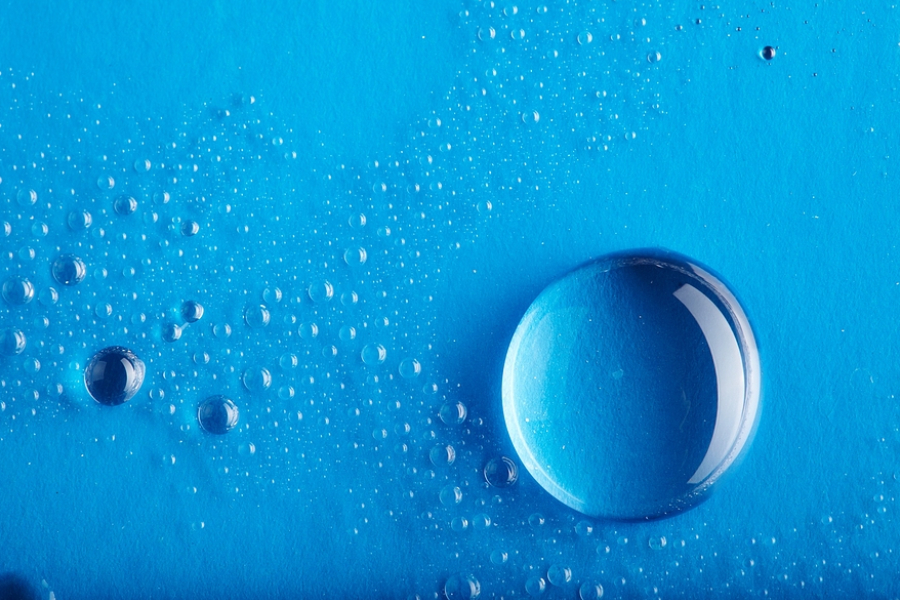Why Water Droplets “Levitate” & Skitter About On Hot Surface

Anybody who cooks knows the trick of telling if the frying pan, wok, or skillet is hot enough by sprinkling some water onto the surface. If the water droplets turn into water vapour immediately, it means that the surface is hot but not ready for cooking. However, if the water droplets skitter about the surface for a while before turning into water vapour, it means that the surface is at the right temperature for cooking.
While this trick is common among households, something is not logical about it. We learn that water evaporates at approximately 100 degrees Celsius. If that is the case, then evaporation will take place faster at higher temperatures. So, why do the water droplets not evaporate immediately at such a high temperature? In this article, we will explore the reason behind such behaviour.
What happens to water on a hot surface?
The boiling point of water is approximately 100 degrees Celsius. The temperature, in layman’s terms, is a measurement of the measured particles’ kinetic energy, meaning that the particles have higher kinetic energy at higher temperatures. As a result, they move around more actively, breaking off their bonds more easily and expanding out to their vapour at a gradual rate.
If you place a water droplet on a surface that has a temperature slightly lower than the boiling point, it flattens out and gets heated slowly. However, if the same water droplet lands on a surface that is at boiling point, it evaporates almost instantly and is accompanied by a hissing sound.
So, what happens if you place the same water droplet on a surface that is above boiling point? At that temperature, the water droplet’s behaviour changes. Because of the extremely hot surface, the base of the water droplet instantly vaporises the moment it touches the surface. As a result, a cushion of steam between the water droplet and the hot surface is created, also known as film boiling, the reason behind the levitating and skittering behaviour of the water droplets, more formally known as the Leidenfrost effect.
What causes the Leidenfrost effect?
This phenomenon occurs when liquid comes into contact with a surface that is significantly hotter than the liquid’s boiling point (100 degrees Celsius). The vapour cushion that is created during film boiling is the reason behind the phenomenon.
The vapour cushion acts as a thermal insulator. Water in its gaseous state has 20 times less thermal conductivity than water in its liquid state. As a result, the vapour cushion prevents heat transmission from the hot surface to the water droplet.
The vapour cushion created is approximately 0.2mm thick at the centre and 0.1mm thick at the sides. Despite it being subtle, the gaseous layer is able to exert adequate upward pressure, resulting in the water droplet staying afloat. The vapour cushion is also sensitive to external disturbances. Because the water droplet hovers over it, friction becomes reduced significantly. Hence, a slight tilt of the surface sends the water droplet skittering across the surface.
The temperature at which the Leidenfrost effect occurs is called the Leidenfrost point. It varies between liquids and is dependent on the nature of the surface and the liquid’s properties.
Do other liquids display this effect?
The Leidenfrost effect can occur to any liquid that is poured over a surface with a temperature higher than its boiling point. Here are some interesting experiments with other liquids to test the Leidenfrost effect.
- -The molten lead experiment: The temperature of molten lead ranges from 300 to 400 degrees Celsius. Before dunking their hands into molten lead, the people dip their hands into liquid water. As a result, the water present on their hands creates a vapour cushion that prevents them from being burnt by the molten lead.
- -Liquid nitrogen experiment: When liquid nitrogen is poured over a surface at room temperature, it appears to glide over the surface like glass beads. This is because the boiling point of liquid nitrogen is approximately -196 degrees Celsius, which is way below the normal room temperature. Hence, the liquid nitrogen experiences film boiling in the situation.
Applications of the Leidenfrost effect
Apart from cool demonstrations, does this phenomenon have any real-life applications?
Yes! In fact, it is applied everywhere, from nuclear reactors to inkjet printers. Nuclear reactors utilise water heat exchangers to maintain their core temperature. In such a situation, the Leidenfrost effect becomes a villain. If the reactor’s temperature becomes too hot, film boiling occurs, hindering the heat transfer from the reactor to the water. Hence, the Leidenfrost effect must always be maintained to prevent the nuclear reactor from overheating, resulting in a nuclear disaster.
There are studies of the Leidenfrost effect being conducted to explore how its motion and levitation properties can be applied in aspects, such as self-propulsion mechanisms. Additionally, scientists are also finding ways to utilise the phenomenon to manipulate fluids’ movements. For example, if the hot surface has repeated sharp ridge designs, the water droplets are able to climb up the ridges. Also, unique mazes designed using hydrophobic coatings and grooved surfaces can manipulate water droplets to move across the desired paths. This kind of manipulation opens up opportunities for fluid dynamics and electric current generation.
Conclusion
The future application of the Leidenfrost effect is limitless. It is a unique example of thermodynamics and the odd nature of physics. Who knows? Maybe one day, mankind can even utilise this phenomenon to allow humanity to run on water like the movies. If this article has piqued your interest in the subject and you would like to learn more, then look no further than Physics Tuition. With experienced teachers and interesting classes, we are able to introduce you to the realm of physics outside your classroom. Contact us to find out more!